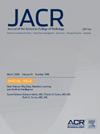Outcomes of Implementation of a Same-Day Breast Biopsy Program in a Safety-Net Public Hospital
IF 5.1
3区 医学
Q1 RADIOLOGY, NUCLEAR MEDICINE & MEDICAL IMAGING
引用次数: 0
Abstract
Purpose
Safety-net hospitals play an important role in providing care to patients from historically underserved groups, representing a natural target for initiatives to reduce health disparities. This study evaluates the implementation of a same-day biopsy (SDB) program on time to breast biopsy in the safety-net setting.
Materials and methods
This study used an interrupted time series design with pre- and postanalysis. After institutional review board approval, all diagnostic and ultrasound (US) examinations leading to US-guided biopsy during the phase-in period (May 2021 to February 2022), official implementation period (March 2022 to April 2023), and follow-up period (May 2023 to December 2023) were identified. Demographic characteristics of the groups using Wilcoxon rank-sum tests for continuous variables in χ2 tests of independence for categorical variables were evaluated. Spline modeling with generalized linear models was used to assess differences in days from biopsy recommendation to biopsy and rates of having a SDB in pre- and postimplementation groups.
Results
A total of 677 patients received recommended US-guided breast biopsies during the study period, with 233 patients in the phase-in group, 306 patients in the official implementation group, and 138 patients in the follow-up group. For all patients, the SDB program reduced the median time from biopsy recommendation to biopsy from 13.0 to 3.5 (interquartile range: 6.0-12.0) days (P < .0001). There was no statistically significant decrease in time from biopsy recommendation to initial surgical (19.0-15.0 days; P = .29) or oncologic (26.0-21.0 days; P = .19) appointment.
Conclusion
Implementation of a SDB program is effective in reducing overall diagnostic delays after a breast biopsy recommendation for patients seen in safety-net institutions. Additional administrative and ancillary support may be required, however, to aid surgical and oncologic services to further improve overall time to treatment in these settings.
某安全网公立医院当日乳腺活检项目实施结果分析。
目的:安全网医院在向历史上服务不足的群体的患者提供护理方面发挥着重要作用,是减少健康差距举措的自然目标。本研究评估了在安全网设置下实施当天活检(SDB)计划的时间。材料与方法:本研究采用前后分析的中断时间序列设计。经IRB批准后,确定了在阶段(2021年5月至2022年2月)、正式实施期(2022年3月至2023年4月)和随访期(2023年5月至2023年12月)进行的所有诊断和超声(US)检查,并进行US引导活检。使用连续变量的Wilcoxon秩和检验对分类变量进行卡方独立性检验,评估各组人口统计学特征。使用广义线性模型的样条建模来评估从推荐活检到活检的天数差异以及实施前和实施后组SDB的发生率。结果:在研究期间,共有677例患者接受了推荐的us引导乳腺活检,其中分期组233例,正式实施组306例,随访组138例。对于所有患者,SDB项目将从推荐活检到活检的中位时间从13.0-3.5天(IQR: 6.0-12.0)缩短(P < 0.0001)。从推荐活检到首次手术的时间没有统计学意义上的减少(19.0-15.0天;P=0.29)或肿瘤(26.0-21.0天;P = 0.19)的约会。结论:实施SDB计划可以有效减少在安全网机构就诊的患者在接受乳房活检建议后的总体诊断延迟。然而,可能需要额外的行政和辅助支持来辅助外科和肿瘤服务,以进一步改善这些环境中的总体治疗时间。
本文章由计算机程序翻译,如有差异,请以英文原文为准。
求助全文
约1分钟内获得全文
求助全文
来源期刊

Journal of the American College of Radiology
RADIOLOGY, NUCLEAR MEDICINE & MEDICAL IMAGING-
CiteScore
6.30
自引率
8.90%
发文量
312
审稿时长
34 days
期刊介绍:
The official journal of the American College of Radiology, JACR informs its readers of timely, pertinent, and important topics affecting the practice of diagnostic radiologists, interventional radiologists, medical physicists, and radiation oncologists. In so doing, JACR improves their practices and helps optimize their role in the health care system. By providing a forum for informative, well-written articles on health policy, clinical practice, practice management, data science, and education, JACR engages readers in a dialogue that ultimately benefits patient care.
 求助内容:
求助内容: 应助结果提醒方式:
应助结果提醒方式:


